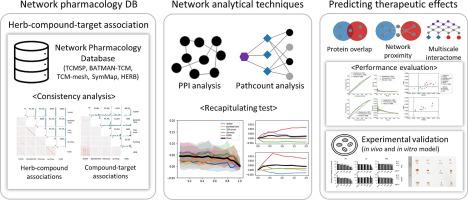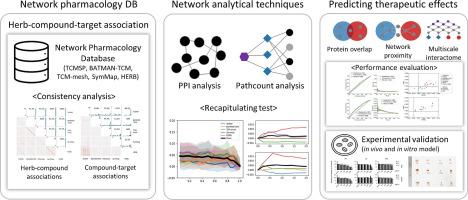评价草药网络药理学的现状,重点是确定其机制和治疗效果
IF 13
1区 综合性期刊
Q1 MULTIDISCIPLINARY SCIENCES
引用次数: 0
摘要
网络药理学作为一种识别草药的机制和治疗效果的工具已经获得了显著的牵引力。然而,尽管这些方法有用,但它们的多样性强调了迫切需要进行系统评价,以确保一致性和可靠性。目的对网络药理学分析进行评价,重点探讨中药的作用机制和治疗作用。方法采用系统的数据检索、网络构建和分析等综合方法。从五个不同的网络药理学数据库中精心提取草药化合物及其靶点,以确保广泛的覆盖范围和高数据可靠性。采用先进的基于网络的方法识别关键草药靶点并预测治疗效果,从而丰富了分析的深度和广度。在前列腺癌模型上进行了实验验证,以证实计算预测。结果基于网络构建和聚合方法,已知中药成分目标的概括任务在性能和覆盖范围上呈现出不同的模式。我们进行了相同的分析来确定草药靶点,发现网络中心性、路径计数和下加权路径计数各有优缺点。通过比较基于网络的方法,我们发现考虑对多尺度相互作用组的影响在区分已知治疗效果方面具有最高的准确性。在最佳条件下,我们成功地确定了草药的新适应症,并通过后续的体外和体内实验验证了这些发现。结论本研究首次对目前中草药领域的网络药理学分析进行了全面和批判性的评价,为进一步阐明其机制和疗效提供了有价值的指导。本文章由计算机程序翻译,如有差异,请以英文原文为准。


Evaluating current status of network pharmacology for herbal medicine focusing on identifying mechanisms and therapeutic effects
Introduction
Network pharmacology has gained significant traction as a tool for identifying the mechanisms and therapeutic effects of herbal medicines. However, despite the usefulness of these approaches, their diversity underscores the critical need for a systematic evaluation to ensure consistency and reliability.
Objectives
We aimed to evaluate the network pharmacological analyses, focusing on identifying the mechanisms and therapeutic effects of herbal medicines.
Methods
We employed a comprehensive approach involving systematic data retrieval, network construction, and analysis. Herbal compounds and their targets were meticulously extracted from five distinct network pharmacology databases to ensure extensive coverage and high data reliability. Advanced network-based methods were used to identify key herbal targets and predict therapeutic effects, thereby enriching the depth and breadth of the analysis. Experimental validation was performed on prostate cancer models to substantiate the computational predictions.
Results
The results of the recapitulating task for known herbal ingredient targets revealed distinct patterns in performance and coverage based on network construction and aggregation methods. We performed the same analysis to identify herbal targets and found that network centrality, path counts, and downweighted path counts had their own pros and cons. By comparing network-based methods, we found that considering the impact on the multiscale interactome yielded the highest accuracy in discriminating known therapeutic effects. Using optimal conditions, we successfully identified new indications for herbal medicines and validated these findings through follow-up in vitro and in vivo experiments.
Conclusion
This study presents the first comprehensive and critical evaluation of the current network pharmacology analyses in the field of herbal medicine and provides valuable guidance for continued advances in the elucidation of the mechanisms and therapeutic effects.
求助全文
通过发布文献求助,成功后即可免费获取论文全文。
去求助
来源期刊

Journal of Advanced Research
Multidisciplinary-Multidisciplinary
CiteScore
21.60
自引率
0.90%
发文量
280
审稿时长
12 weeks
期刊介绍:
Journal of Advanced Research (J. Adv. Res.) is an applied/natural sciences, peer-reviewed journal that focuses on interdisciplinary research. The journal aims to contribute to applied research and knowledge worldwide through the publication of original and high-quality research articles in the fields of Medicine, Pharmaceutical Sciences, Dentistry, Physical Therapy, Veterinary Medicine, and Basic and Biological Sciences.
The following abstracting and indexing services cover the Journal of Advanced Research: PubMed/Medline, Essential Science Indicators, Web of Science, Scopus, PubMed Central, PubMed, Science Citation Index Expanded, Directory of Open Access Journals (DOAJ), and INSPEC.
 求助内容:
求助内容: 应助结果提醒方式:
应助结果提醒方式:


